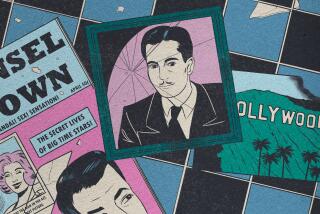‘Lavender’ Looks for Hints of Homosexuality in Vintage Films
Mark Rappaport’s “The Silver Screen: Color Me Lavender” is more exasperating than provocative in its relentless intent to read male homosexual implications into a wide array of vintage Hollywood--and a couple of European--movies.
The documentary’s narrator, “Frasier’s” Dan Butler, reiterates how everything is open to interpretation, but clearly Rappaport sees only one reading--subliminal hanky-panky between Bob Hope and Bing Crosby in their “Road” movies, between Jerry Lewis and Dean Martin in their comedies, between perennial old codger Walter Brennan and John Wayne or Gary Cooper or James Stewart. The list is endless.
The problem is that Rappaport--director of the far more impressive “From the Journals of Jean Seberg”--has too narrow a perspective. He seems reluctant to acknowledge that heterosexual American males might be from time to time insecure in their masculinity and that comedy involving drag or homosexual innuendo can be a way of releasing that anxiety. To see clips of Hope, with both Crosby and others, is to be reminded of just how funny he is and what a secure man he must be to poke occasional fun at masculine insecurities.
The amazing thing is how, by and large, inoffensive the humor involving homosexuality and effeminacy is in Rappaport’s choices of old clips. This is all the more remarkable when you consider how conclusively and powerfully the late Vito Russo’s landmark study “The Celluloid Closet” and its subsequent documentary argue that movies have historically been instrumental in the oppression, ridiculing and stereotyping of gays.
Like Russo before him--and critic-historian Andrew Sarris before that--Rappaport calls attention to the proliferation of clearly, if not openly, gay characters in ‘30s movies played by such character actors as Franklin Pangborn, Eric Blore and Edward Everett Horton, who enlivened many a movie with their sly wit and humor. (Outside the characters played by these three men, the only man in all the clips that seems to be unmistakably gay is Wendell Corey’s heavily repressed pal to John Hodiak in the 1947 “Desert Fury.”)
Rappaport surveys the screen images of a number of long-ago male stars, some of whom are widely believed to have been gay, and uses film clips to substantiate that assumption. But he never takes into account that they are being directed in roles that they didn’t write. (If you have a wide enough array of clips at your disposal, you can argue just about anything.)
He makes an interesting point about Brennan when he reminds us that as a sidekick, he was perennially trying to steer the star away from the girl in hopes of settling down on some ranch with him. But couldn’t it be that these codgers, instead of being repressed gays, are more often than not simply afraid they will be abandoned in their old age?
What Rappaport really accomplishes, although this does not seem his intention, is to remind us that males, regardless of sexual orientation, have a simple, sometimes deep, need to bond and that this bond may just be emotional rather than sexual.
What matters finally is not whether movie characters--past, present or future--are gay but whether their portrayal is harmfully irresponsible and offensive. In the meantime, maybe it would be a good thing for everyone to lighten up.
* Unrated. Times guidelines: The film deals with mature subject matter.
‘The Silver Screen: Color Me Lavender’
A Planet Pictures presentation of a Couch Potato production. Writer-director-editor Mark Rappaport. Producer Nancy Schreiber. Narrator Dan Butler. Running time: 1 hour, 40 minutes.
* At the Music Hall, 9036 Wilshire Blvd., Beverly Hills, (310) 274-6869.
More to Read
Only good movies
Get the Indie Focus newsletter, Mark Olsen's weekly guide to the world of cinema.
You may occasionally receive promotional content from the Los Angeles Times.










